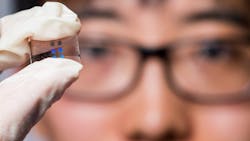Metasurface camera lens to link between quantum computers and fiber-optic networks
An international team led by researchers at Australian National University (ANU; Canberra, Australia) has invented a small camera lens based on optical metasurfaces, aimed at facilitating links between quantum computers and fiber-optic networks.1 Quantum computers promise a new era in ultrasecure networks, artificial intelligence, and therapeutic drugs, and will be able to solve certain problems much faster than today's classical computers.
The lens is made of a silicon film with millions of resonant nanostructures that in sum form a metasurface less than a micrometer thick. The metasurface camera lens is highly transparent, thereby enabling efficient transmission and detection of information encoded in quantum light, says ANU associate professor Andrey Sukhorukov.
Reconstruction of photon states
The lens was used to image multiple projections of polarization-encoded quantum states, including their amplitude, phase, coherence, and entanglement. Polarization-insensitive click detectors placed after the metasurface allowed reconstruction of one- and two-photon states; future experiments could reconstruct higher photon numbers.
Kai Wang, a PhD scholar at the Nonlinear Physics Centre who worked on all aspects of the project, said one challenge was making portable quantum technologies. "Our device offers a compact, integrated, and stable solution for manipulating quantum light," says Kai. "It is fabricated with a similar kind of manufacturing technique used by Intel and NVIDIA for computer chips." (In other words, the fabrication process is CMOS-compatible.)
The research was conducted at the Nonlinear Physics Centre laboratories, where staff and postgraduate scholars developed and trialled the metasurface camera lens in collaboration with researchers at the Oak Ridge National Laboratory in the United States and the National Central University in Taiwan.
Source: http://www.anu.edu.au/news/all-news/tiny-camera-lens-may-help-link-quantum-computers-to-network
REFERENCE:
1. Kai Wang et al., Science (2018); doi: 10.1126/science.aat8196.

John Wallace | Senior Technical Editor (1998-2022)
John Wallace was with Laser Focus World for nearly 25 years, retiring in late June 2022. He obtained a bachelor's degree in mechanical engineering and physics at Rutgers University and a master's in optical engineering at the University of Rochester. Before becoming an editor, John worked as an engineer at RCA, Exxon, Eastman Kodak, and GCA Corporation.
